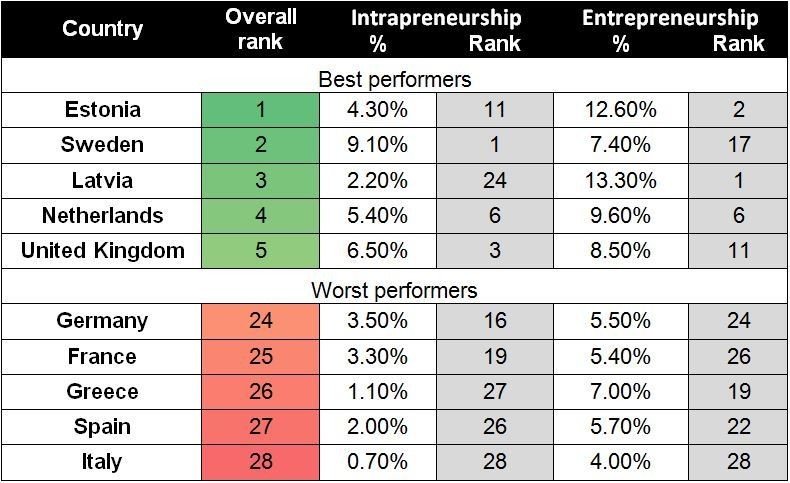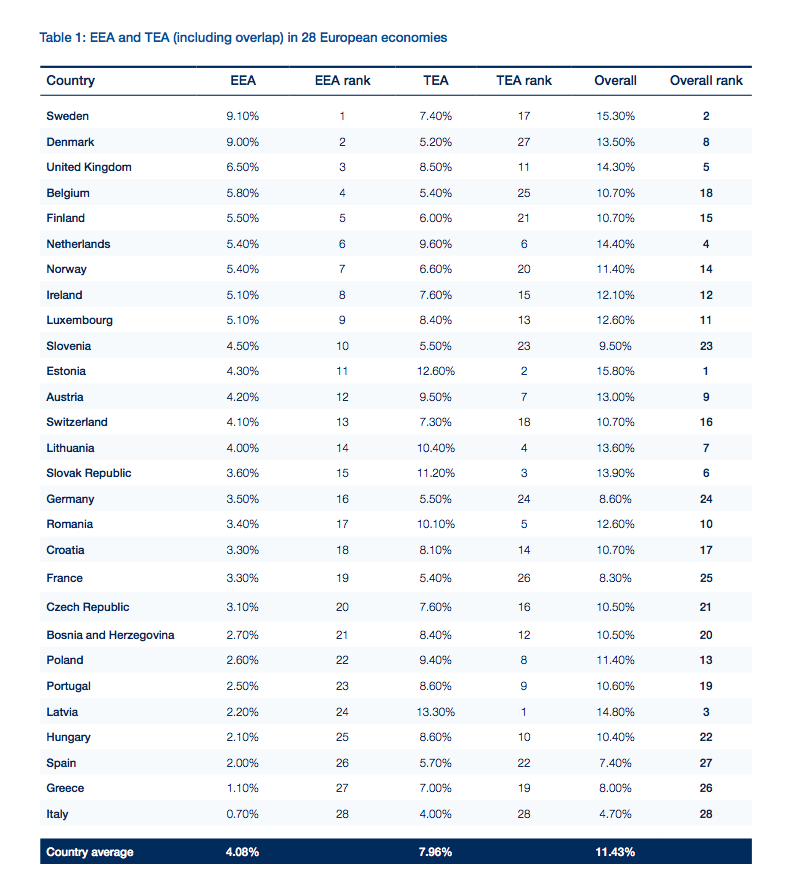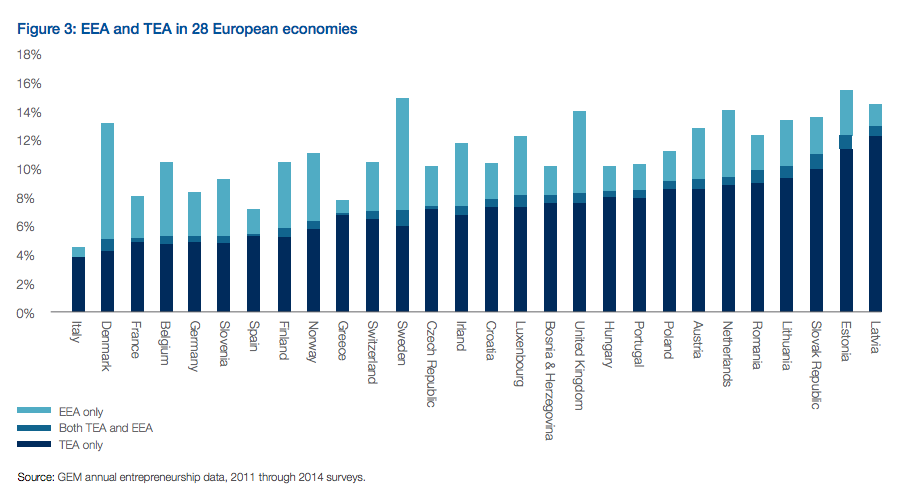There’s a defining scene in “Social Network” where Napster creator Sean Parker (Justin Timberlake) says to Facebook co-founders Mark Zuckerberg and Eduardo Saverin, “A million dollars isn’t cool. You know what’s cool?
“A billion dollars.”
Whether or not they say it out loud, every American entrepreneur has that in the back of his or her mind. And an amazing number of digital entrepreneurs from Zuckerberg to Jeff Bezos at Amazon have put waaay more than a billion in the bank in a fraction of the time it took the old Robber Barons such as Cornelius Vanderbilt and J.P. Morgan.
Moreover, the Cool Kids have built giant innovative and disruptive digital businesses employing hundreds of thousands of people around the world, many earning crazy money.
So, empire building – not to mention money for nothin’ and your chicks for free – at least in part, powers the U.S. digital wave that sweeps away all competitors.
The mystery that befuddles Europe’s policymakers is, “Why has Europe never produced a Uber, Airbnb, Facebook, Amazon or Google?
“Why is there no Silicon Valley here? Where are our entrepreneurs?”
Why with twice the population of the U.S. and equal or even superior double-doc tech talent, Europe never manages to produce dominant, consumer-facing tech companies? Only companies Silicon Valley acquires, or tweaks into new products.
Well, this could be the first mystery solved for 2017.
The Geneva-based World Economic Forum has a just-released report, “Europe’s Hidden Entrepreneurs: Entrepreneurial Employee Activity and Competitiveness in Europe” that’s as verbose and dense as its title suggests.
BUT, the research by the group that gives you the Davos power meetings each year is solid, data-rich and revealing.
It all comes down to one word:
The report finds that in the dominant European economies such as Germany, there is no celebration of entrepreneurism. There is no cult of a Steve Jobs-like figure. There are no German startup heroes kids grow up emulating like Sean Parker, loathsome as he is, and no “Silicon Valley” TV series … the ultimate pop culture imprimatur.
More crucially, Europe really has no group as influential and productive as the PayPal Mafia – Peter Thiel, Elon Musk, Reid Hoffman and others – who’ve gone on to create mega-success after mega-success such as Tesla, LinkedIn and Palantir.
In Europe, people crazy enough to, you know, actually risk capital are acting mostly out of desperation. WEF researchers even have a name for it: “Entrepreneurism as a last resort.”
Seriously ….
What is Entrepreneurship?
 So what is entrepreneurship? It’s seeing a need and filling it, right?
So what is entrepreneurship? It’s seeing a need and filling it, right?
In that sense, an entrepreneurial culture doesn’t necessarily guarantee a competitive economy. And a competitive economy doesn’t necessarily foster an entrepreneurial culture.
Germany is Europe’s dominant economy. Yet “Hidden Entrepreneurs” ranks Germany only 24th for overall entrepreneurship.
Why does it matter? Because just since World War II, we’ve seen every major economy on earth (with the possible exception of Switzerland) transformed by globalization.
Take China. China went from being a cheap-labor country producing toys, textiles and ceramics to the most advanced manufacturing economy on the verge of conquering the world. China now is creating digital technology that rivals Silicon Valley including smartphones and communications apps such as WeChat. The U.S. went from being a heavy industry-based economy in 1950 to finance and high-tech becoming by far the most important sectors in 2017.
Europe’s economy, on the other hand, is still focused on 20th century technologies such as autos, conventional finance and insurance and conventional pharmaceuticals.
Sure, Germany, the Netherlands, Great Britain and other European mega-economies do these better than anyone else. But what’s the new new thing that’s going to sustain their economies?
 If you don’t read the entire 30-page “Hidden Entrepreneurs” report, read the preface here:
If you don’t read the entire 30-page “Hidden Entrepreneurs” report, read the preface here:
A major feature of the Fourth Industrial Revolution is the decentralization of innovation. Historically, innovation came from legendary laboratories or the state-of-the-art research campuses of large corporations and educational institutions. Now the next big breakthrough is likely to come from a suburban garage, cramped apartment or college dorm room.
Americans have known this since the end of World War II. The Europeans not so much.
The report divides Europe’s innovation into two categories:
- Total Early-Stage Entrepreneurial Activity (TEAs)
- Entrepreneurial Employee Activity (EEAs)
TEAs are the men and women in pure startups. EEAs are the exceptional talents inside big companies working on their own projects, either on the side or with the support of their employers.
By now, you’re asking yourself, “So, which countries have both?””
Aha! You’ve hit on the data the study says too many policy makers and economists are overlooking. Though the findings won’t surprise you. Europe’s strongest economies have both. But, the rankings might surprise you.
The Top 5 when you include both entrepreneurs inside companies and the hardy souls outside companies are:
1 – Estonia
2 – Sweden
3 – Latvia
4 – Netherlands
5 – United Kingdom
Okay, now here’s where we get to plug our home base of the Netherlands. No. 4 Netherlands is one of the countries where both trends are present. Its TEA rank is No. 6. Its EEA rank is No. 6. Though the Netherlands leans more toward the pure startup side than top rated Sweden and Denmark.
So, WEF research shows Europe doesn’t lack entrepreneurs as is commonly assumed. Many just choose to innovate inside larger organizations. Which we’ve seen over and over again in Eindhoven, where electronics giant Philips has spun off successful ultra-high-tech companies such as ASML.
The problem is, the ASMLs of the world don’t employ sufficient numbers of people. And they tend to only employ highly skilled engineers and physicists. Which means they don’t absorb sufficient numbers of less highly skilled workers like an Amazon, which has about 140,000 employees compared to ASML’s 12,000.
Americans do; Europeans meet
Dispatches started out a year ago pondering why Europe does some things so well, such as medtech, but can’t produce a dominant market concept.
The longer we’ve been based in Eindhoven, Europe’s emerging high-tech innovation capital, the better we’ve understood how important big companies are to producing the new new thing, as Michael Lewis has dubbed next-gen innovation as practiced in Silicon Valley.
One of the obvious reasons is that Silicon Valley and the rest of the US, as well as China, moves quickly to the next development cycle with total alacrity. Ideas are born. Capital flows and companies start in a matter of weeks or even days while the Europeans are still meeting.
The Europeans spend too much time analyzing and digesting what they think is the latest innovation, not realizing their tweaks and updates are too late. That’s just as true with Rocket Internet’s knock-offs of Amazon and Zappos as it is with Finland’s early domination of cell phones and wireless technology.
Some of the best take aways from the “Hidden Entrepreneurs” report:
• Since the 1960s, Germany has lacked an entrepreneurial culture and tradition. There are few popular images of founders in the country. The opportunity cost for highly qualified, employed individuals is very high and risk aversion is a strong trait in German society. This discourages many would-be entrepreneurs from taking the leap. However, necessity-based entrepreneurship in Germany is relatively high as a proportion of TEA compared with other northern and western European countries, possibly reflecting successful government programmes to support self-employment out of unemployment following the Hartz reforms. This reinforces an image of solo self-employment out of necessity rather than opportunity-based, growth-oriented, innovative entrepreneurship.
• In addition, Germany’s economic structure plays a role in its level of entrepreneurial activity. To a large degree, Germany depends on innovative (but not necessarily high-tech) and established (but not necessarily large) firms. Its economic backbone is the so-called “Mittelstand,” that is, medium-sized, very innovative and international firms, which are more prevalent in the south and west of Germany. This concentration of innovation in Mittelstand firms can, in part, account for low TEA and moderate EEA rates, given that those firms rely heavily on keeping innovation in-house.
Now, compare Germany to Poland, which has an entrepreneurial culture in the transition from an efficiency-driven economy to an innovation-driven economy:
Poland’s entrepreneurial activity is mostly expressed in TEA. This is driven by a highly entrepreneurial culture: a high percentage of the population believes they have the required skills to start a business (53%) and knows someone who has started a business in the past two years (39%). What stands out most about entrepreneurs in Poland, however, is that almost half of them have necessity-based motives. This means that a large portion of Poland’s TEA could be entrepreneurship as a last resort. By comparison, in Denmark only one-tenth of nascent and new entrepreneurs are necessity-driven. In fact, Poland and Denmark have the same rate of opportunity-based TEA. Hence, without necessity-based TEA, Poland would rank in the lower third of the table alongside Denmark, but without the higher-quality EEA to make up for it. Given a better economic environment then, Poland’s TEA rate is expected to drop.
Italy might be the biggest entrepreneurial puzzle in the study. A country that has churned out the best in autos, luxury goods and apparel is hamstrung by an essentially Third-World lack of viable and reliable institutions providing the stability and predictability that make innovation possible.
Conversely, tiny Estonia has all the ingredients to emerge as Europe’s next great innovation center; stability, efficient markets, sound policy and … wait for it … culture!
From “Hidden Entrepreneurs”:
…in the last decade, Estonia has seen a number of success stories, which have elevated entrepreneurship visibly in the public eye. Most notably, Skype’s success has inspired a whole generation of Estonian entrepreneurs. Former Skype employees have gone on to start their own companies, while the original four Estonian co-founders have made significant investments in new ventures. Recently, David McClure, Founder of start-up accelerator 500 Startups, went so far as to coin the co-founders the “Estonian mafia,” a tongue-in-cheek reference to Silicon Valley’s “PayPal mafia.”
Or as they say in The Valley, “Hola, hola, hola … We ‘dem boyz!”
The bottom line is, it’s not all about GDP. Nurturing entrepreneurial culture today builds the foundation for tomorrow’s dominant innovation-driven economies.
Co-CEO of Dispatches Europe. A former military reporter, I'm a serial expat who has lived in France, Turkey, Germany and the Netherlands.
















